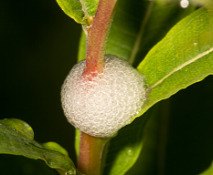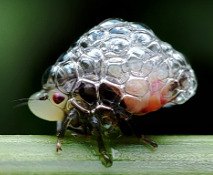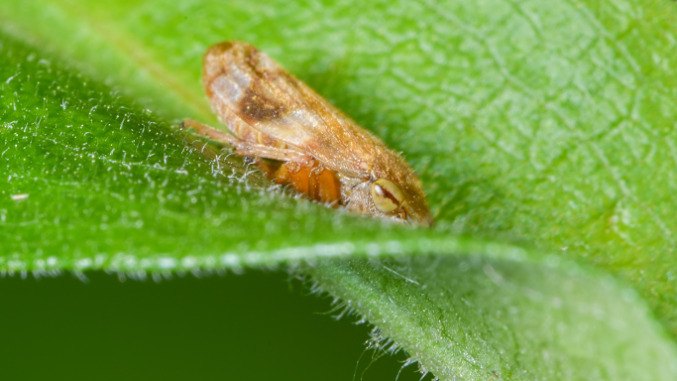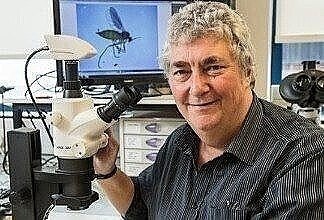
Foam on your plants? It’s probably froghoppers – Here’s what you need to know
2 Minute Read
Dr Ian Bedford tells us everything we need to know about the 'bug of the month' for June the Froghopper.What are Froghoppers?
While you are out and about in your garden this month you will have most likely encountered blobs of bubbly foam on a wide range of herbaceous plants, often referred to as ‘Cuckoo Spit’. While the arrival of said bubbly foam blobs coincides with the arrival of migratory Cuckoos each year, they are not actually the ‘spit’ of Cuckoos, or any other saliva-producing animal for that matter. In fact, it is created by juvenile Froghoppers, a Hemipteran, sap-sucking group of insects that are closely related to leafhoppers, planthoppers and aphids.
Froghoppers (also known as Spittlebugs) are common insects throughout the British Isles, and 10 native species can be found. During spring, the Froghopper’s eggs (which will have been laid on plant stems during autumn), hatch into small pale green nymphs, that are almost immobile. To protect themselves from predation and desiccation, the nymphs create a blob of foam to live within, by mixing expelled air into the waste fluids that they excrete whilst feeding on their host plant’s sap.
Froghoppers (also known as Spittlebugs) are common insects throughout the British Isles, and 10 native species can be found. During spring, the Froghopper’s eggs (which will have been laid on plant stems during autumn), hatch into small pale green nymphs, that are almost immobile. To protect themselves from predation and desiccation, the nymphs create a blob of foam to live within, by mixing expelled air into the waste fluids that they excrete whilst feeding on their host plant’s sap.



Froghopper identification, behaviour, and control tips
The species that’s most often seen in Britain’s gardens will be the Meadow froghopper Philaenus spumarius, and by mid-Summer, these nymphs will have matured and vacate their frothy blobs as robust and highly mobile adults.
Adult froghoppers are around 6mm in length and with their characteristic pointed heads and tapered bodies, resemble the shape of a squatting frog. Despite having the ability to fly, Froghoppers invariably move by leaping, using their relatively short back legs with powerful muscles to propel themselves 150 times their own body length at a velocity of 13,000 ft per second.
Of the ten species of froghopper that occur in Britain, nine of them are an earthy mottled brown colour which makes them well camouflaged and difficult to see within foliage. One species however, Cercopis vulnerate, is a striking red and black colour and is the largest of Britain’s froghopper species.
Although commonly found in home gardens, Froghoppers will rarely ever infest plants in large enough numbers to become a harmful plant pest. However, if their ‘cuckoo spit’ is considered a problem on certain plants, then a short squirt from the garden hose would remove it and the nymph within.
Although commonly found in home gardens, Froghoppers will rarely ever infest plants in large enough numbers to become a harmful plant pest. However, if their ‘cuckoo spit’ is considered a problem on certain plants, then a short squirt from the garden hose would remove it and the nymph within.

Are Froghoppers a threat to native plants?
One thing that’s worth noting though, is that in certain locations of southern Europe and the Americas, froghoppers can acquire and transmit a lethal bacterial disease of plants called Xylella (Xylella fastidiosa). This disease is particularly affecting Olive groves, and while this disease has never been recorded in Britain, there is a possibility that native species would be able to transmit Xylella should they have access to infected plants.
So, for this reason, strict measures are now in place to prevent the importation of plants, such as Olive from locations where Xylella is present, to ensure that living plant material isn’t brought into Britain by returning travellers and holidaymakers.
So, for this reason, strict measures are now in place to prevent the importation of plants, such as Olive from locations where Xylella is present, to ensure that living plant material isn’t brought into Britain by returning travellers and holidaymakers.

About Dr Ian Bedford
Ian has been fascinated by the bug world for as long as he can remember. From studying butterflies on the South Downs as a youngster, he went on to pursue a career in Research Entomology and ran the Entomology Dept at the John Innes Centre in Norwich up until his recent retirement.Visit website

'Bug of the month'
Visit our 'bug of the month' archive.
Every month Ian will share his knowledge on how to protect your plants and gardens from preventable pest invasions while providing valuable insights into the insects regularly found in our gardens.
find out moreComments (0)
Why not be the first to send us your thoughts?
